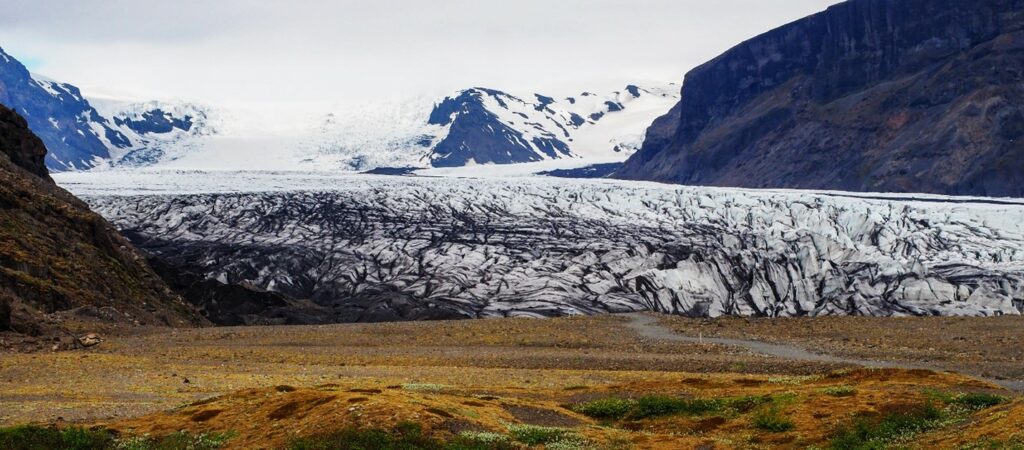4: Glaciation
- Page ID
- 25485
\( \newcommand{\vecs}[1]{\overset { \scriptstyle \rightharpoonup} {\mathbf{#1}} } \)
\( \newcommand{\vecd}[1]{\overset{-\!-\!\rightharpoonup}{\vphantom{a}\smash {#1}}} \)
\( \newcommand{\dsum}{\displaystyle\sum\limits} \)
\( \newcommand{\dint}{\displaystyle\int\limits} \)
\( \newcommand{\dlim}{\displaystyle\lim\limits} \)
\( \newcommand{\id}{\mathrm{id}}\) \( \newcommand{\Span}{\mathrm{span}}\)
( \newcommand{\kernel}{\mathrm{null}\,}\) \( \newcommand{\range}{\mathrm{range}\,}\)
\( \newcommand{\RealPart}{\mathrm{Re}}\) \( \newcommand{\ImaginaryPart}{\mathrm{Im}}\)
\( \newcommand{\Argument}{\mathrm{Arg}}\) \( \newcommand{\norm}[1]{\| #1 \|}\)
\( \newcommand{\inner}[2]{\langle #1, #2 \rangle}\)
\( \newcommand{\Span}{\mathrm{span}}\)
\( \newcommand{\id}{\mathrm{id}}\)
\( \newcommand{\Span}{\mathrm{span}}\)
\( \newcommand{\kernel}{\mathrm{null}\,}\)
\( \newcommand{\range}{\mathrm{range}\,}\)
\( \newcommand{\RealPart}{\mathrm{Re}}\)
\( \newcommand{\ImaginaryPart}{\mathrm{Im}}\)
\( \newcommand{\Argument}{\mathrm{Arg}}\)
\( \newcommand{\norm}[1]{\| #1 \|}\)
\( \newcommand{\inner}[2]{\langle #1, #2 \rangle}\)
\( \newcommand{\Span}{\mathrm{span}}\) \( \newcommand{\AA}{\unicode[.8,0]{x212B}}\)
\( \newcommand{\vectorA}[1]{\vec{#1}} % arrow\)
\( \newcommand{\vectorAt}[1]{\vec{\text{#1}}} % arrow\)
\( \newcommand{\vectorB}[1]{\overset { \scriptstyle \rightharpoonup} {\mathbf{#1}} } \)
\( \newcommand{\vectorC}[1]{\textbf{#1}} \)
\( \newcommand{\vectorD}[1]{\overrightarrow{#1}} \)
\( \newcommand{\vectorDt}[1]{\overrightarrow{\text{#1}}} \)
\( \newcommand{\vectE}[1]{\overset{-\!-\!\rightharpoonup}{\vphantom{a}\smash{\mathbf {#1}}}} \)
\( \newcommand{\vecs}[1]{\overset { \scriptstyle \rightharpoonup} {\mathbf{#1}} } \)
\( \newcommand{\vecd}[1]{\overset{-\!-\!\rightharpoonup}{\vphantom{a}\smash {#1}}} \)
\(\newcommand{\avec}{\mathbf a}\) \(\newcommand{\bvec}{\mathbf b}\) \(\newcommand{\cvec}{\mathbf c}\) \(\newcommand{\dvec}{\mathbf d}\) \(\newcommand{\dtil}{\widetilde{\mathbf d}}\) \(\newcommand{\evec}{\mathbf e}\) \(\newcommand{\fvec}{\mathbf f}\) \(\newcommand{\nvec}{\mathbf n}\) \(\newcommand{\pvec}{\mathbf p}\) \(\newcommand{\qvec}{\mathbf q}\) \(\newcommand{\svec}{\mathbf s}\) \(\newcommand{\tvec}{\mathbf t}\) \(\newcommand{\uvec}{\mathbf u}\) \(\newcommand{\vvec}{\mathbf v}\) \(\newcommand{\wvec}{\mathbf w}\) \(\newcommand{\xvec}{\mathbf x}\) \(\newcommand{\yvec}{\mathbf y}\) \(\newcommand{\zvec}{\mathbf z}\) \(\newcommand{\rvec}{\mathbf r}\) \(\newcommand{\mvec}{\mathbf m}\) \(\newcommand{\zerovec}{\mathbf 0}\) \(\newcommand{\onevec}{\mathbf 1}\) \(\newcommand{\real}{\mathbb R}\) \(\newcommand{\twovec}[2]{\left[\begin{array}{r}#1 \\ #2 \end{array}\right]}\) \(\newcommand{\ctwovec}[2]{\left[\begin{array}{c}#1 \\ #2 \end{array}\right]}\) \(\newcommand{\threevec}[3]{\left[\begin{array}{r}#1 \\ #2 \\ #3 \end{array}\right]}\) \(\newcommand{\cthreevec}[3]{\left[\begin{array}{c}#1 \\ #2 \\ #3 \end{array}\right]}\) \(\newcommand{\fourvec}[4]{\left[\begin{array}{r}#1 \\ #2 \\ #3 \\ #4 \end{array}\right]}\) \(\newcommand{\cfourvec}[4]{\left[\begin{array}{c}#1 \\ #2 \\ #3 \\ #4 \end{array}\right]}\) \(\newcommand{\fivevec}[5]{\left[\begin{array}{r}#1 \\ #2 \\ #3 \\ #4 \\ #5 \\ \end{array}\right]}\) \(\newcommand{\cfivevec}[5]{\left[\begin{array}{c}#1 \\ #2 \\ #3 \\ #4 \\ #5 \\ \end{array}\right]}\) \(\newcommand{\mattwo}[4]{\left[\begin{array}{rr}#1 \amp #2 \\ #3 \amp #4 \\ \end{array}\right]}\) \(\newcommand{\laspan}[1]{\text{Span}\{#1\}}\) \(\newcommand{\bcal}{\cal B}\) \(\newcommand{\ccal}{\cal C}\) \(\newcommand{\scal}{\cal S}\) \(\newcommand{\wcal}{\cal W}\) \(\newcommand{\ecal}{\cal E}\) \(\newcommand{\coords}[2]{\left\{#1\right\}_{#2}}\) \(\newcommand{\gray}[1]{\color{gray}{#1}}\) \(\newcommand{\lgray}[1]{\color{lightgray}{#1}}\) \(\newcommand{\rank}{\operatorname{rank}}\) \(\newcommand{\row}{\text{Row}}\) \(\newcommand{\col}{\text{Col}}\) \(\renewcommand{\row}{\text{Row}}\) \(\newcommand{\nul}{\text{Nul}}\) \(\newcommand{\var}{\text{Var}}\) \(\newcommand{\corr}{\text{corr}}\) \(\newcommand{\len}[1]{\left|#1\right|}\) \(\newcommand{\bbar}{\overline{\bvec}}\) \(\newcommand{\bhat}{\widehat{\bvec}}\) \(\newcommand{\bperp}{\bvec^\perp}\) \(\newcommand{\xhat}{\widehat{\xvec}}\) \(\newcommand{\vhat}{\widehat{\vvec}}\) \(\newcommand{\uhat}{\widehat{\uvec}}\) \(\newcommand{\what}{\widehat{\wvec}}\) \(\newcommand{\Sighat}{\widehat{\Sigma}}\) \(\newcommand{\lt}{<}\) \(\newcommand{\gt}{>}\) \(\newcommand{\amp}{&}\) \(\definecolor{fillinmathshade}{gray}{0.9}\)After reading this chapter, completing the exercises within it, and answering the questions at the end, you should be able to:
- Describe the timing and extent of the Earth’s past glaciations,
- Describe the important geological events that led up to the Pleistocene glaciations,
- Explain how Milankovitch orbital variations along with positive feedback mechanisms, have controlled the timing of those glaciations,
- Describe the differences between continental and alpine glaciation,
- Summarize how snow and ice accumulate above the equilibrium line and get converted to ice,
- Explain how basal sliding and internal flow facilitate the movement of ice from the upper part to the lower part of a glacier,
- Describe and identify the various landforms related to alpine glacial erosion, including U-shaped valleys, arêtes, cols, horns, hanging valleys, truncated spurs, drumlins, roches moutonées, glacial grooves and striae,
- Identify various types of glacial lakes, including tarns, finger lakes, moraine lakes and kettle lakes,
- Describe the nature, origins and importance of various types of glacial sediments, and
- Explain how anthropogenic climate change is affecting glaciers, and why that matters, and how glaciation contributes to Earth-system processes.
- 4.1: Glacial Periods in Earth’s History
- This page discusses Earth's ongoing glacial period, which began 34 million years ago and intensified 1 million years ago, marked by cycles of glaciation roughly every 100,000 years. Key glacial events include major periods during the Phanerozoic and persistent cooling in the Cenozoic era due to tectonic and climatic shifts.
- 4.2: How Glaciers Work
- This page explains two glacier types: continental glaciers, found in polar regions, and alpine glaciers in mountains. Continental glaciers hold most of the world's ice and fresh water, while movement depends on internal dynamics, temperature, and the equilibrium line. Glacial motion balances between advance and ablation; if advance exceeds ablation, glaciers move forward, or else they may retreat.
- 4.3: Glacial Erosion
- This page discusses the erosion caused by glaciers, noting that they shape landscapes differently based on type: continental glaciers create flat surfaces while alpine glaciers carve U-shaped valleys. It highlights features such as horns, arêtes, and cirques, and mentions the formation of glacial lakes, including tarns and finger lakes.
- 4.4: Glacial Deposits
- This page discusses how Pleistocene glaciations influenced sediment transport and deposition in Canada and the northern US, creating vital construction materials and groundwater reservoirs. It highlights various unconsolidated sediment types such as till and glacio-fluvial deposits, as well as features like moraines, kettle lakes, and eskers formed by glacial activities.
- 4.5: Glaciers and Climate Change, Glaciers and Earth Systems
- This page discusses the significant impacts of anthropogenic climate change on glaciers, particularly noting the Athabasca Glacier's annual retreat of about 5 meters. Global glacier mass loss contributes to sea level rise, alters ocean salinity and currents, and affects freshwater supplies. The melting glaciers pose risks such as slope failures and permafrost destabilization, while also threatening ecosystems, tourism, and the hydrological cycle through reduced water flow and increased erosion.
- 4.6: Chapter 4 Summary and Questions for Review
- This page examines glaciation, covering historical glacial periods, glacier formation, and flow mechanics. It discusses glacial erosion, deposits, and landscape shaping, like U-shaped valleys, alongside the effects of climate change on glacier retreat. The chapter also includes review questions to enhance understanding of glacial processes and their geological importance.

A glacier is a long-lasting (decades or more) body of ice on land, that is large enough (at least tens of metres thick and at least hundreds of metres in extent) to move under its own weight. About 10% of the Earth’s land surface is currently covered with glacial ice, and although the vast majority of that is in Antarctica and Greenland, there are many glaciers in other places. At various times during the past million years glacial ice has been much more extensive than it is now, with ice covering as much as 30% of the land surface.
Glaciers presently represent the largest repository of fresh water on the Earth (~69% of all fresh water), and they are highly sensitive to changes in climate. In the current warming climate glaciers everywhere are melting rapidly, and although some of the larger glacial masses will still last for centuries, many smaller glaciers, will be gone within decades, in some cases within years. That is much more than just a troubling thought for people that find glaciers fascinating and beautiful. Many people, around the world, rely on glacial ice for their water supplies, including drinking water and water to grow food. Changes to glaciers also have implications for mass wasting; that topic is covered in Chapter 5.
Media Attribution
Figure 4.0.1 Photo by Isaac Earle, 2016. Used with permission, CC BY 4.0


